Accardi L., Freudenberg W., Obya M. (Eds.) Quantum Bio-informatics IV: From Quantum Information to Bio-informatics
Подождите немного. Документ загружается.

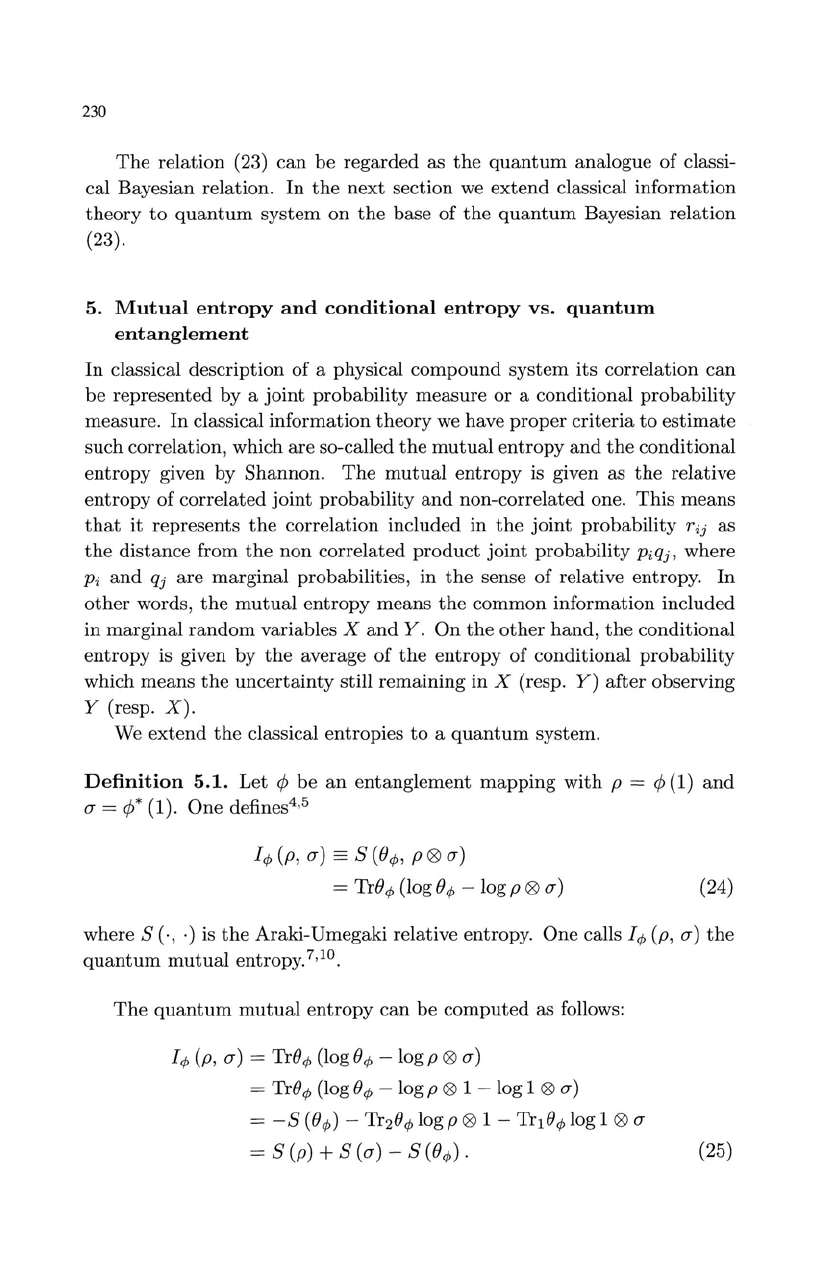
230
The
relation (23)
can
be
regarded
as
the
quantum
analogue
of
classi-
cal Bayesian relation.
In
the
next
section we
extend
classical information
theory
to
quantum
system
on
the
base
of
the
quantum
Bayesian re
lation
(23).
5.
Mutual
entropy
and
conditional
entropy
vs.
quantum
entanglement
In classical description of a physical
compound
system
its correlation
can
be
represented by a
joint
probability measure
or
a conditional
probability
measure. In classical information
theory
we have
proper
criteria
to
estimate
such correlation, which
are
so-called
the
mutual
entropy
and
the
conditional
entropy
given by Shannon.
The
mutual
entropy
is given as
the
relative
entropy
of
correlated joint probability
and
non-correlated one.
This
means
that
it
represents
the
correlation included in
the
joint
probability
Tij
as
the
distance from
the
non
correlated
product
joint
probability
Piqj,
where
Pi
and
qj
are
marginal probabilities, in
the
sense
of
relative entropy. In
other
words,
the
mutual
e
ntropy
means
the
common
information included
in marginal
random
variables X
and
Y.
On
the
other
hand,
the
conditional
entropy
is given by
the
average
of
the
entropy
of
conditional probability
which means
the
uncertainty
still remaining in X (resp. Y)
after
observing
Y (resp.
X).
We
extend
the
classical entropies
to
a
quantum
system.
Definition
5.1.
Let ¢
be
an
entanglement
mapping
with
p = ¢
(1)
and
0"
= ¢* (1).
One
defines
4
,5
1¢(p,
0")
==
8(8¢,
p®
O")
= Tr8 ¢ (log 8 ¢ - log p ®
0")
(24)
where
8 (',
.)
is
the
Araki-Umegaki relative entropy. One calls 1¢
(p,
0")
the
quantum
mutual
entropy. 7,
10.
The
quantum
mutual
e
ntropy
can
be
computed
as follows:
1¢
(p,
0")
= Tr8¢ (log8¢
-logp
®
0")
= Tr8 ¢ (log 8 ¢ - log p ® 1 - log 1 ®
0")
=
-8
(8¢) -
Tr
2
8¢ log p ® 1 -
Tr
1
8¢ log 1 ®
0"
=8(p)+8(0")-8(8
¢)
.
(25)
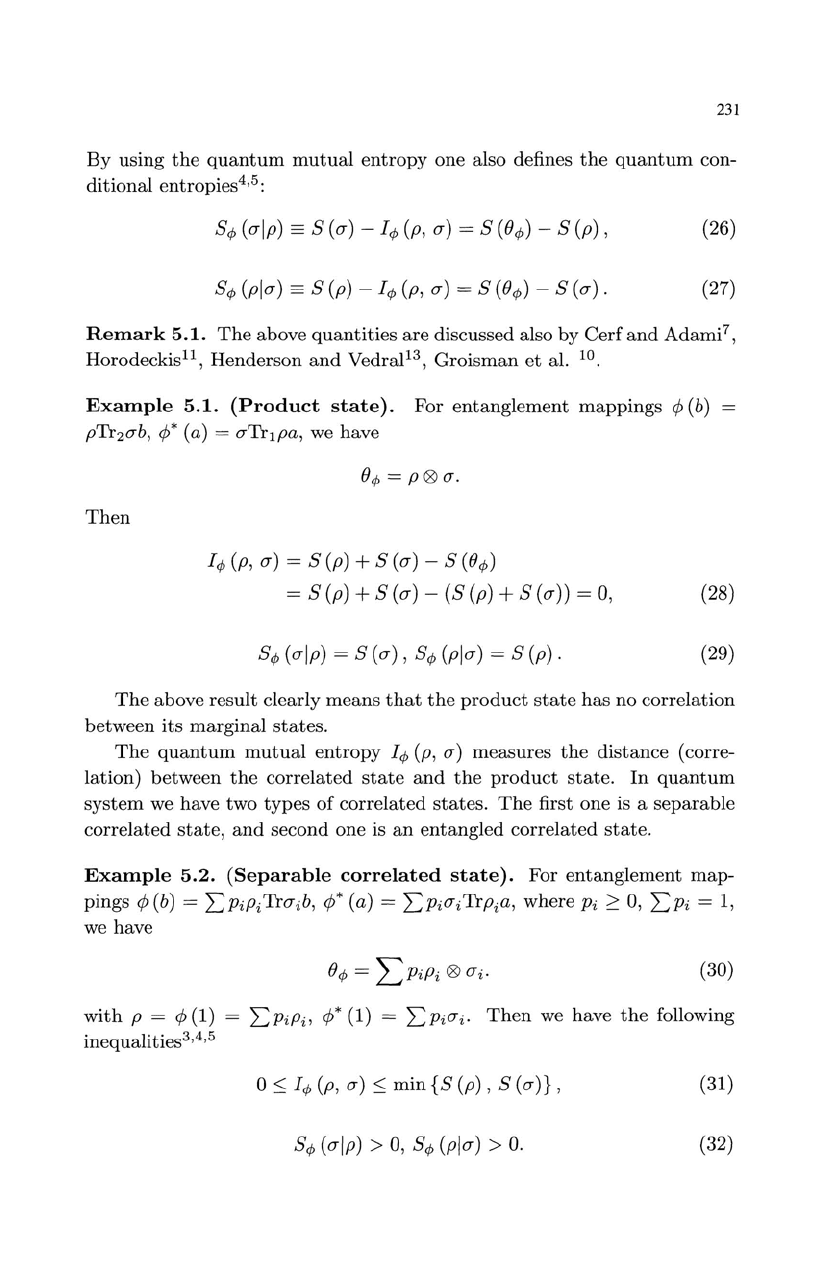
231
By
using
the
quantum
mutual
entropy one also defines
the
quantum
con-
ditional entropies
4
,5:
S</>
(alp)
==
S (a) -
I</>
(p,
a) = S
(8</»
- S
(p)
, (26)
S</>
(pia)
==
S
(p)
-
I</>
(p,
a) = S
(8</»
- S (a) .
(27)
Remark
5.1.
The
above quantities are discussed also
by
Cerf
and
Adami
7
,
Horodeckisll, Henderson
and
Vedral
13
, Groisman
et
al.
10.
Example
5.1.
(Product
state).
For entanglement mappings ¢
(b)
pTr2ab, ¢* (a) = aTr1pa, we have
8</>
= p 0 a.
Then
I
</>
(p
, a) = S
(p)
+ S (a) - S
(8</»
=S(p)+S(a)-(S(p)+S(a))=O,
(28)
S
</>
(alp) = S (a) , S
</>
(pia) = S
(p)
.
(29)
The
above result clearly means
that
the
product
state
has no correlation
between
its
marginal
stat
e
s.
The
quantum
mutual
e
ntropy
I</>
(p,
a) measures
the
distance (corre-
lation)
betw
een
the
corre
lated
state
and
the
product
state.
In
quantum
system we have two types of correlated states.
The
first one is a separable
correlated
state,
and
second one is
an
entangled correlated
state.
Example
5.2.
(Separable
correlated
state).
For entanglement map-
pings
¢
(b)
=
'2:.
Pi
Pi
Tra
ib, ¢* (a) = '2:.PWiTrpia, where
Pi
~
0,
'2:.P
i = 1,
we have
(30)
with
p = ¢ (1) =
'2:.PiP
i' ¢* (1) = '2:.PWi.
Then
we have
the
following
inequalities
3
,4,5
0::;
I</>
(p,
a)
::;
min {S
(p)
, S (a)} ,
(31)
S
</>
(alp) >
0,
S
</>
(p
ia) >
0.
(32)
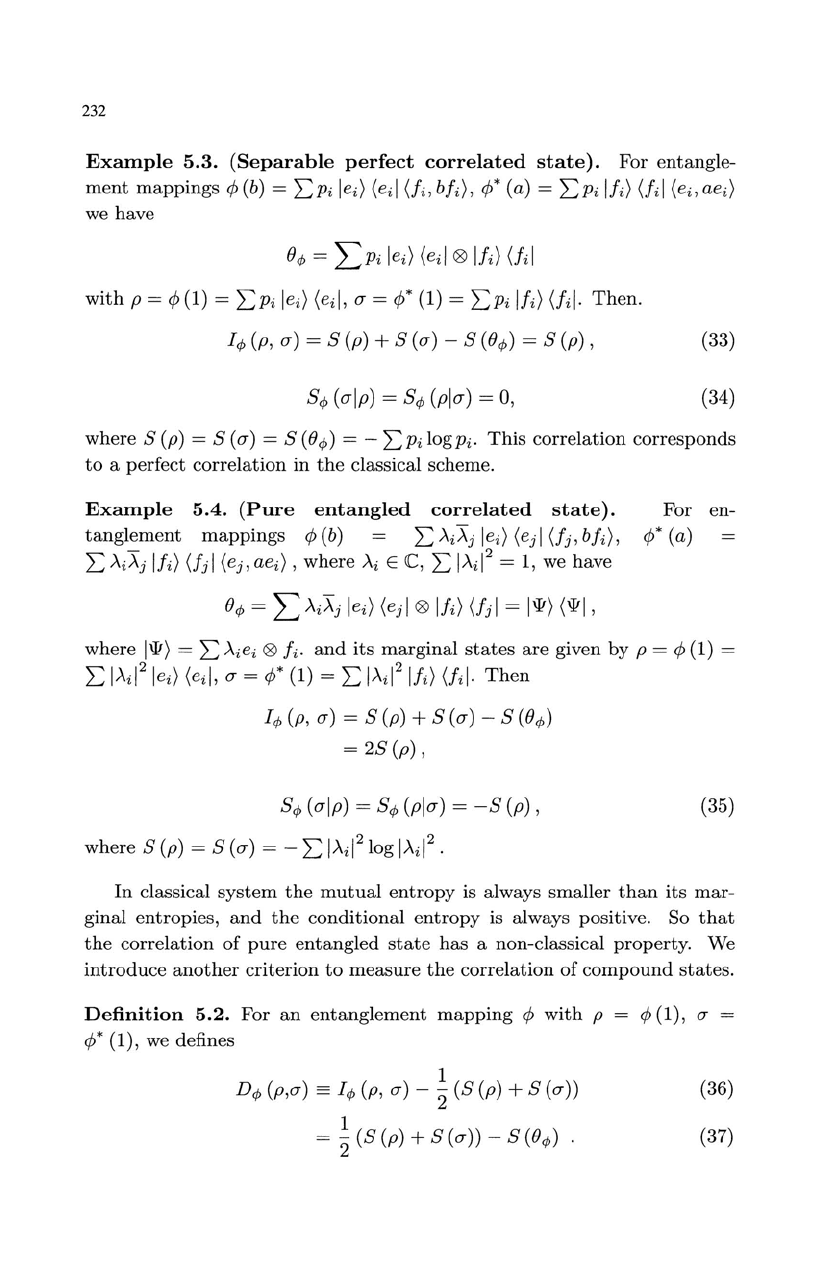
232
Example
5.3.
(Separable
perfect
correlated
state).
For entangle-
ment
mappings
¢(b)
=
LPi
lei) (eil
(fi,bi
i
),
¢* (a) =
LPi
1M
(fil (ei,aei)
we
have
8¢
=
I>i
lei) (eil 0 I!i) (fil
with
p = ¢
(1)
=
LPi
lei) (eil,
(J
= ¢*
(1)
=
LPi
1M
(fil.
Then.
1¢
(p,
(J)
= 5
(p)
+ 5
((J)
- 5 (8¢) = 5 (p),
(33)
where 5
(p)
= 5
((J)
= 5 (8¢) = -
LPi
logpi.
This
correlation corresponds
to
a perfect correlation in
the
classical scheme.
Example
5.4.
(Pure
entangled
correlated
state).
For en-
tanglement
mappings
¢(b)
LAi"Xj
lei) (ejl
(fj,bM,
¢* (a)
- 2
LAiAj
1M
(fJl
(ej,aei)
, where
Ai
E C, L
IAil
=
1,
we have
8¢
= L
Ai"Xj
lei) (ej I 0 Iii) (fJ I =
IW)
(WI,
where
IW)
= L Aiei 0 k
and
its marginal
states
are
given by p = ¢
(1)
=
L I
A
il
2
l
e
i) (eil,
(J
=
¢*
(1)
= L I
A
il
2
lii)
(fil.
Then
1¢
(p,
(J)
= 5
(p)
+ 5
((J)
- 5 (8¢)
=
25
(p),
5¢
((Jlp)
= 5¢
(pl(J)
=
-5
(p)
,
where 5
(p)
= 5
((J)
= - L IAil2log
IAil2
.
(35)
In
classical
system
the
mutual
entropy
is always smaller
than
its
mar-
ginal entropies,
and
the
conditional
entropy
is always positive. So
that
the
correlation
of
pure
entangled
state
has
a non-classical property. We
introduce
another
criterion
to
measure
the
correlation of
compound
states.
Definition
5.2. For
an
entanglement
mapping
¢
with
p = ¢ (1),
(J
=
¢* (1), we defines
1
D¢
(pp)
==
1¢
(p,
(J)
-
"2
(5
(p)
+ 5
((J))
1
=
"2
(5
(p)
+ 5
((J))
- 5
(8
¢ )
(36)
(37)
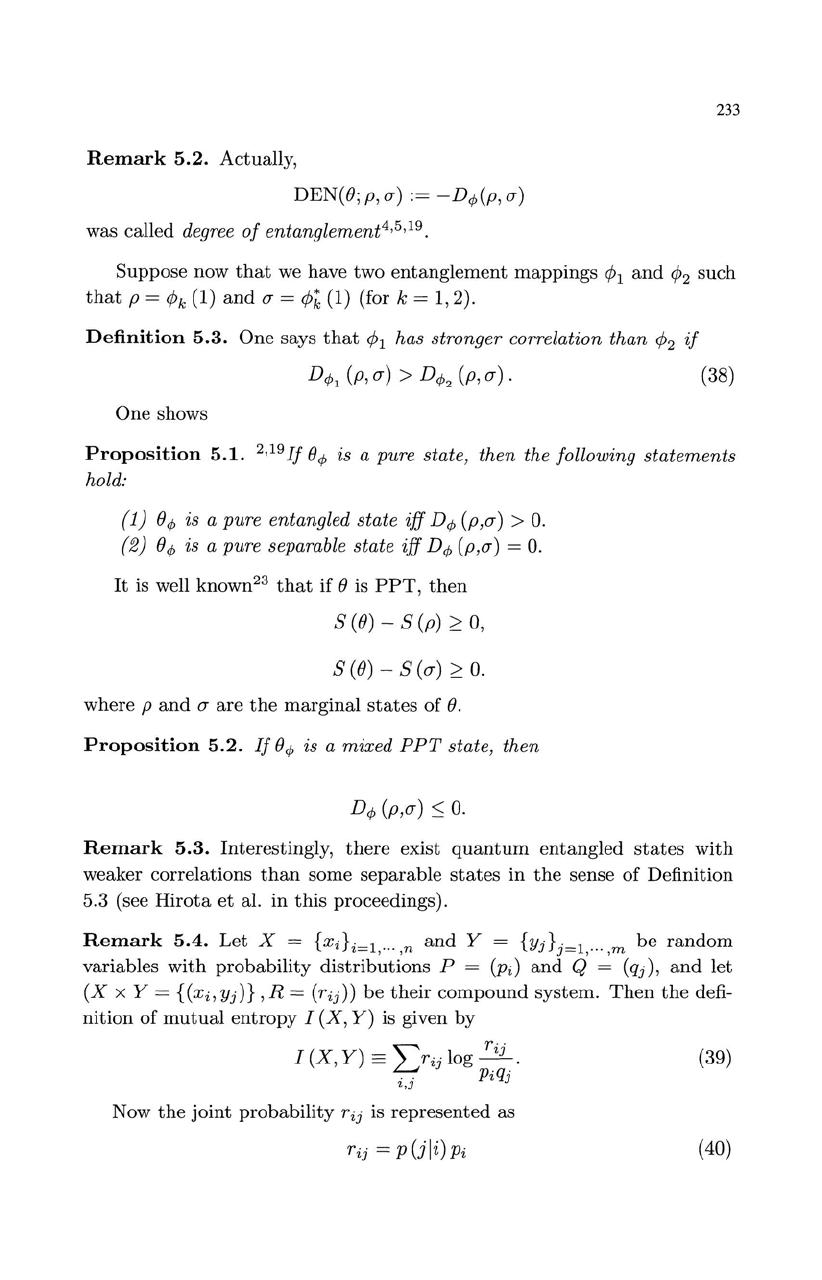
Remark
5.2.
Actually,
DEN(B;
p,
a)
:=
-Dq,(p, a)
was called degree
of
entanglement
4
,5,19.
233
Suppose now
that
we have two
entanglement
mappings
rP1
and
rP2
such
that
p =
rPk
(1)
and
a =
rP~
(1) (for k =
1,2).
Definition
5.3.
One says
that
rP1
has stronger correlation
than
rP2
if
Dq"
(p,a) >
Dq,2
(p,a).
(38)
One
shows
Proposition
5.1.
2,19
If
Bq,
is a pure state,
then
the following
statements
hold:
(1)
Bq,
is a pure entangled state
iff
Dq,
(p,a) >
O.
(2)
Bq,
is a pure separable state
iff
Dq,
(p,a) =
O.
It
is well known
23
that
if B is
PPT,
then
S(B) -
S(p)
~
0,
S(B) -
S(a)
~
O.
where p
and
a are
the
marginal
states
of
B.
Proposition
5.2.
If
Bq,
is a
mixed
PPT
state,
then
Remark
5.3.
Interestingly,
there
exist
quantum
entangled
states
with
weaker correlations
than
some separable
states
in
the
sense
of
Definition
5.3 (see
Hirota
et
al. in
this
proceedings).
Remark
5.4.
Let
X = {Xi}i=l,.
..
,n
and
Y = {Yj}j=l,
...
,m
be
random
variables
with
probability
distributions
P = (Pi)
and
Q = (qj),
and
let
(X
x Y = {(Xi, Yj)} , R =
(r
ij))
be
their
compound
system.
Then
the
defi-
nition
of
mutual
entropy
I (X,
Y)
is given by
Now
the
joint
probability rij is represented as
rij
=p(jli)Pi
(39)
(40)
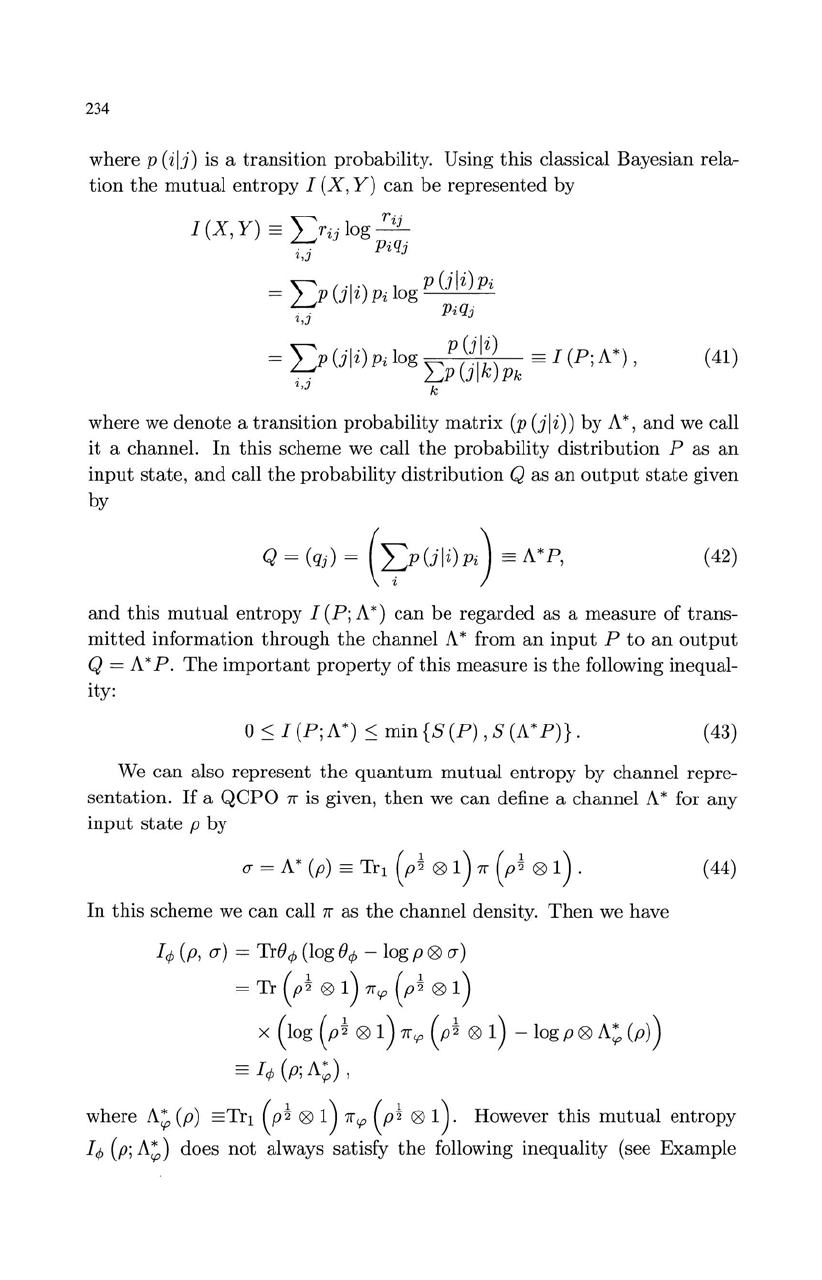
234
where P (ilJ) is a
transition
probability, Using
this
classical Bayesian rela-
tion
the
mutual
entropy
I
(X,
Y)
can
be
represented
by
r·
.
I
(X,
Y)
=
Lrij
log
---2.L
· . Piqj
',J
'"
('I
') 1
p(jli)pi
=
~P
J Z
Pi
og
· . Piqj
',J
'"
( 'I·) 1
p(jli)
I(P
A*)
=
~P
J Z
Pi
og
'"
('Ik)
= ; ,
· .
~P
J
Pk
' ,J k
(
41)
where
we
denote
a
transition
probability
matrix
(p
(j Ii)) by A
*,
and
we call
it
a channel.
In
this
scheme we call
the
probability
distribution
P
as
an
input
state
,
and
call
the
probability
distribution
Q
as
an
output
state
given
by
( 42)
and
this
mutual
entropy
I (P; A *)
can
be
regarded
as
a
measure
of
trans-
mitted
information
through
the
channel A * from
an
input
P
to
an
output
Q = A *
P,
The important
property
of
this
measure
is
the
following inequal-
ity:
0::;
I(P;A*)::;
min{S(P)
,
S(A*P)},
(43)
We
can
also
represent
the
quantum
mutual
entropy
by
channel repre-
sentation,
If
a
QCPO
7f is given,
then
we
can
define a channel A * for
any
input
state
p
by
In
this
scheme we
can
call 7f as
the
channel density,
Th
en
we
have
I
4>
(p,
0')
=
Tre4>
(log
e4>
-l
og p 0
0')
= Tr
(p~
0
1)
7f<p
(p~
0
1)
x
(log
(p
~
0
1)
7f
<p
(p
~
0
1)
- log p 0
A~
(p)
)
=
I4>
(p;
A~)
,
(44)
where
A~
(p)
=Tr
1
(p
~
0
1)
7f
<p
(p
~
0
1)
, However
this
mutual
entropy
I
4>
(p;
A~)
does
not
always satisfy
the
following inequality (see
Example
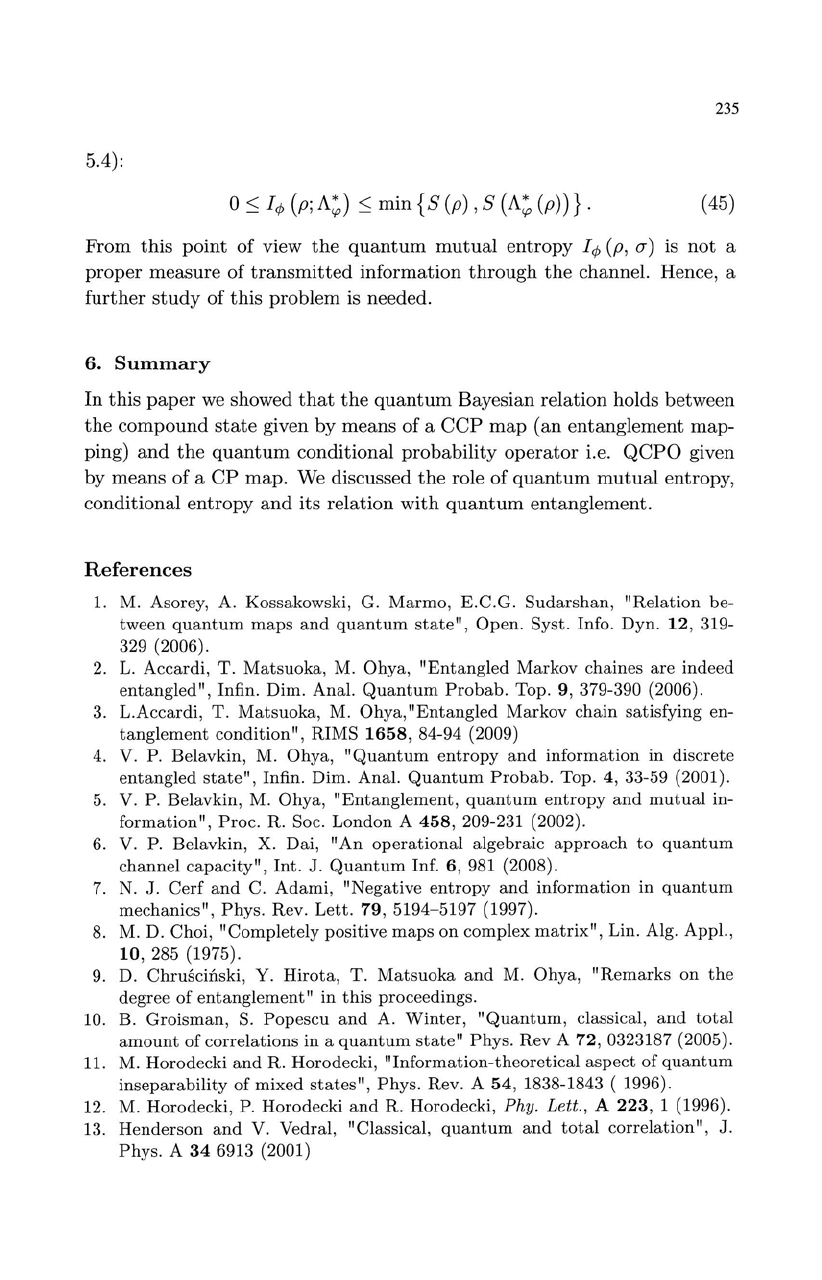
235
5.4):
o
::;
I
q,
(p;
A~)
::;
min
{ S
(p)
, S
(A~
(p))) . ( 45)
From
this
point
of
view
the
quantum
mutual
entropy
1q,
(p,
0')
is
not
a
proper
measure
of
transmitted
information
through
the
channel. Hence, a
further
study
of
this
problem
is needed.
6.
Summary
In
this
paper
we
showed
that
the
quantum
Bayesian
relation
holds
between
the
compound
state
given
by
means
of
a CCP
map
(an
entanglement
map-
ping)
and
the
quantum
conditional
probability
operator
i.e.
QCPO
given
by
means
of a
CP
map.
We discussed
the
role
of
quantum
mutual
entropy,
conditional
entropy
and
its
relation
with
quantum
entanglement.
References
1.
M. Asorey, A. Kossakowski, G.
Marmo,
E.C.G.
Sudarshan,
"Relation
be-
tween
quantum
maps
and
quantum
state",
Open.
Syst.
Info.
Dyn.
12,
319-
329
(2006).
2.
L. Accardi,
T.
Matsuoka,
M.
Ohya,
"Entangled
Markov
chaines
are
indeed
entangled",
Infin. Dim.
Anal.
Quantum
Probab.
Top. 9, 379-390 (2006).
3. L.Accardi,
T.
Matsuoka,
M.
Ohya,
"Entangled
Markov
chain
satisfying
en-
tanglement
condition",
RIMS
1658,
84-94 (2009)
4. V. P. Belavkin, M.
Ohya,
"Quantum
entropy
and
information
in
discrete
entangled
state",
Infin. Dim. Anal.
Quantum
Probab.
Top.
4,
33-59 (2001).
5. V. P. Belavkin, M.
Ohya,
"Entanglement,
quantum
entropy
and
mutual
in-
formation",
Proc.
R. Soc.
London
A
458,
209-231 (2002).
6. V. P. Belavkin, X. Dai,
"An
operational
algebraic
approach
to
quantum
channel
capacity",
Int.
J.
Quantum
Inf. 6, 981 (2008).
7.
N. J.
Cerf
and
C.
Adami,
"Negative
entropy
and
information
in
quantum
mechanics",
Phys.
Rev.
Lett.
79,
5194-5197 (1997).
8. M. D.
Choi,
"Completely
positive
maps
on
complex
matrix",
Lin. Alg. Appl.,
10,
285 (1975).
9.
D. Chrusciiiski, Y.
Hirota,
T.
Matsuoka
and
M.
Ohya,
"Remarks
on
the
degree
of
entanglement"
in
this
proceedings.
10. B.
Groisman,
S.
Popescu
and
A.
Winter,
"Quantum,
classical,
and
total
amount
of
correlations
in a
quantum
state"
Phys.
Rev
A
72,
0323187 (2005).
11. M. Horodecki
and
R.
Horodecki,
"Information-theoretical
aspect
of
quantum
inseparability
of
mixed
states",
Phys.
Rev. A
54,1838-1843
(1996).
12. M. Horodecki, P. Horodecki
and
R. Horodecki, Phy. Lett., A
223,
1 (1996).
13.
Henderson
and
V. Vedral, "Classical,
quantum
and
total
correlation",
J.
Phys.
A
34
6913 (2001)
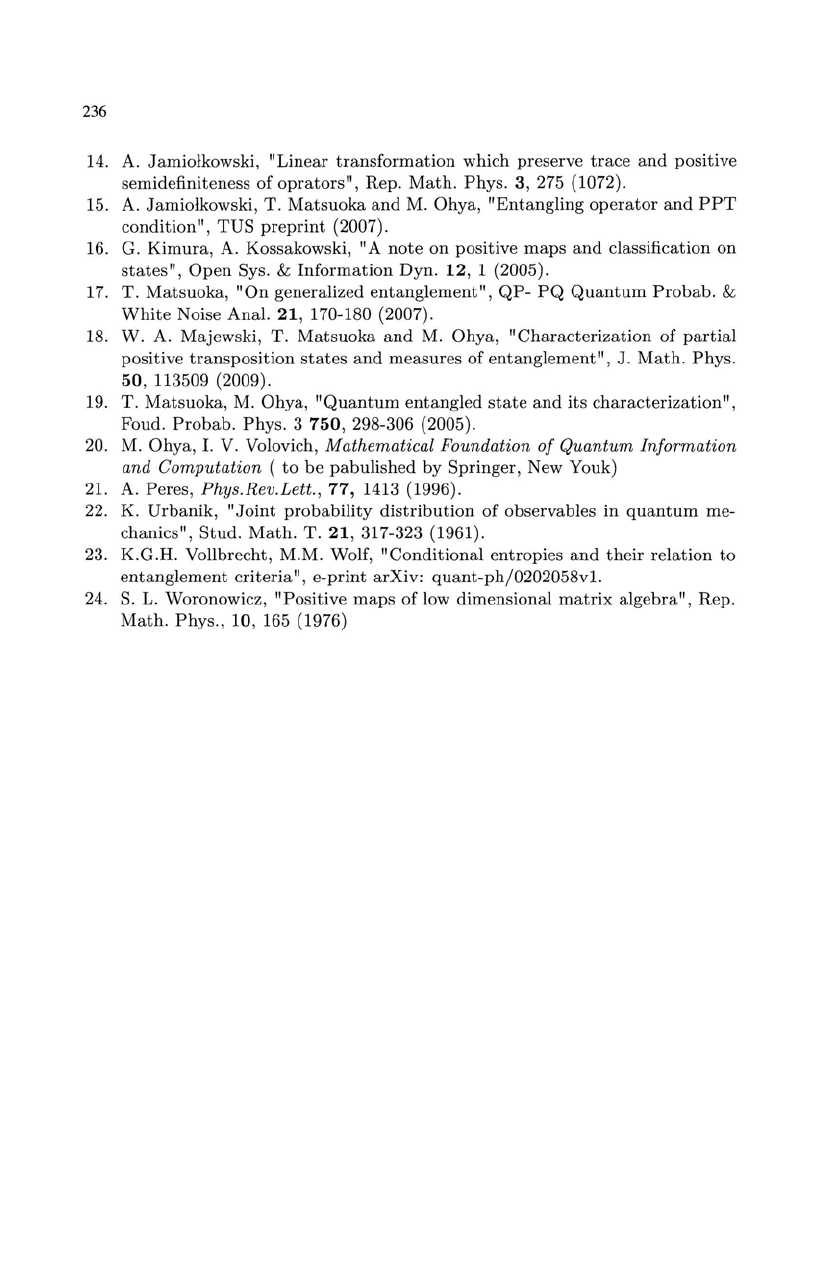
236
14. A. Jamiolkowski,
"Linear
transformation
which
pres
erve
trace
and
positive
semidefiniteness
of
oprators",
Rep.
Math
.
Phys.
3, 275 (1072).
15. A. Jamiolkowski,
T.
Matsuoka
and
M.
Ohya
,
"Entangling
operator
and
PPT
condition",
TUS
preprint
(2007).
16. G.
Kimura,
A. Kossakowski,
"A
note
on
positive
maps
and
classification
on
states",
Open
Sys. &
Information
Dyn
.
12,
1 (2005).
17.
T.
Matsuoka,
"On
generalized
entangl
e
ment"
,
QP-
PQ
Quantum
Probab.
&
White
Noise Anal.
21
, 170-180 (2007).
18.
W.
A. Majewski,
T.
Matsuoka
and
M.
Ohya
,
"Characterization
of
partial
positive
transposition
states
and
measures
of
entanglement",
J.
Math.
Phys.
50,
113509 (2009).
19.
T.
Matsuoka
, M.
Ohya
,
"Quantum
entangled
state
and
its
characterization",
Foud.
Probab.
Phys
. 3
750
, 298-306 (2005).
20.
M.
Ohy
a,
1.
V. Volovich, Mathematical Foundation
of
Quantum
Information
and
Computation
(
to
be
pabulished
by Springer, New Youk)
21. A. Peres, Phys.Rev.Lett.,
77,
1413 (1996).
22. K.
Urbanik
,
"Joint
probability
distribution
of
observables
in
quantum
me-
chanics",
Stud.
Math.
T.
21,317-323
(1961).
23.
K.G
.H. Vollbrecht, M.M. Wolf,
"Conditional
entropies
and
their
relation
to
entangl
e
ment
criteria"
,
e-print
arXiv
:
quant-ph/0202058v1.
24.
S.
L. Woronowicz, "Positive
maps
of low dimensional
matrix
algebra",
Rep.
Math.
Phys.,
10, 165 (1976)
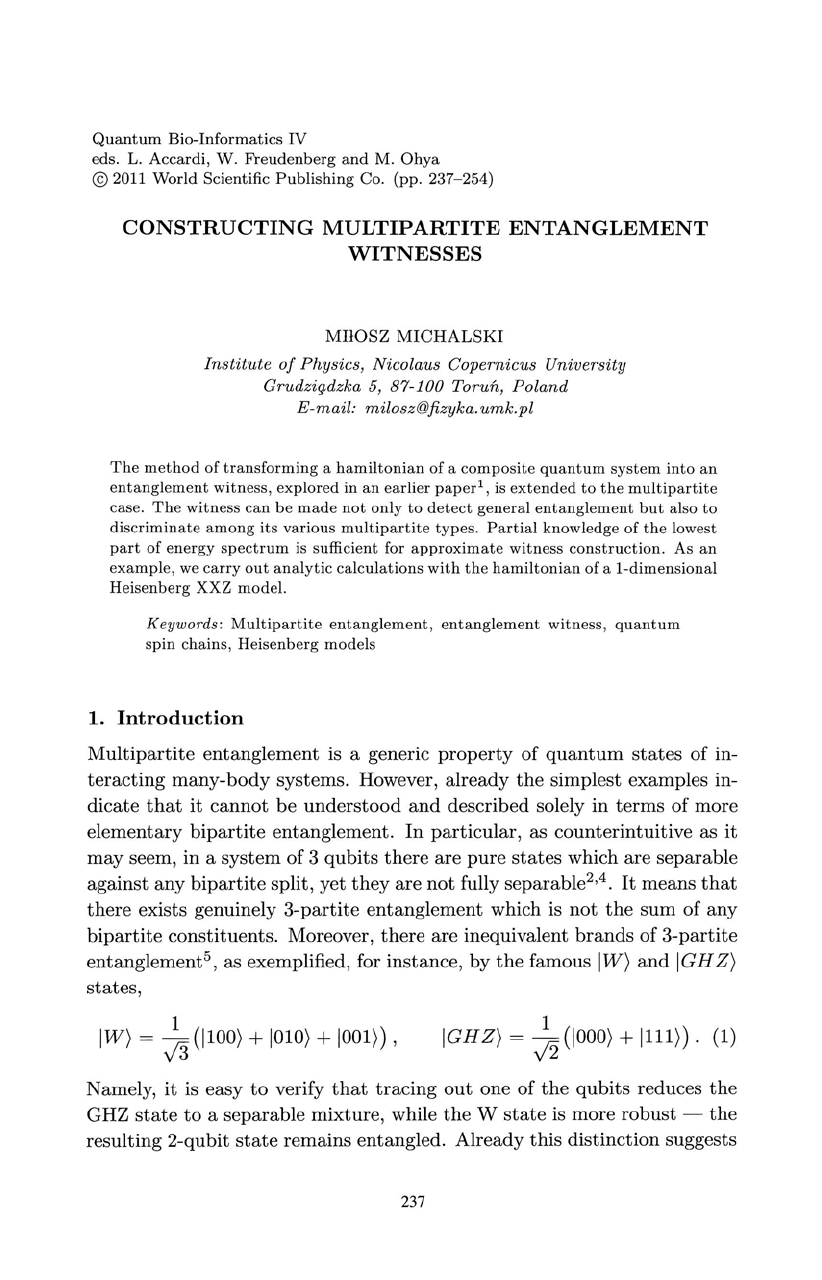
Quantum
Bio-Informatics
IV
eds.
1.
Accardi,
W.
Freudenberg
and
M.
Ohya
© 2011
World
Scientific
Publishing
Co.
(pp.
237- 254)
CONSTRUCTING
MULTIPARTITE
ENTANGLEMENT
WITNESSES
MHOSZ MICHALSKI
Institute
of
Physics, Nicolaus Copernicus University
Grudzir;,dzka
5,
87-100 Torun, Poland
E-mail
: milosz@Jizyka.umk.pl
The
method
of
transforming
a
hamiltonian
of
a
composite
quantum
system
into
an
entang
l
ement
witness
,
explored
in
an
ea
rlier
paper
l
,
is
extended
to
the
multipartite
case.
The
witness
can
be
made
not
only
to
detect
genera
l
entang
l
ement
but
also
to
discriminate
among
its
various
multipartite
types.
Partial
knowledge
of
the
lo
west
part
of
energy
spectrum
is suffici
ent
for
approximate
witness
construction.
As
an
examp
le, we
carry
out
analytic
calculations
with
the
hamiltonian
of
a
I-dim
ensiona
l
Heisenberg
XXZ
model.
Keywords:
Multipartite
entanglement,
entang
lement
witness,
quantum
spin
chains,
Heisenberg
models
1.
Introduction
Multipartite
entanglement
is a generic
property
of
quantum
states
of
in-
teracting
many-body
systems. However, already
the
simplest examples in-
dicate
that
it
cannot
be
understood
and
described solely
in
terms
of
more
elementary
bipartite
entanglement.
In
particular,
as counterintuitive as
it
may
seem,
in
a
system
of
3
qubits
there
are
pur
e
states
which
are
separable
against
any
bipartite
split, yet
they
are
not
fully separable
2
,
4.
It
means
that
there
exists genuinely
3-partite
entanglement
which is
not
the
sum
of
any
bipartite
constituents. Moreover,
there
are inequivalent
brands
of
3-partite
entanglement
5
,
as exemplified, for
instance
, by
the
famous IW)
and
IGHZ
)
states,
IW) =
~
(1100)
+
1010)
+
1001))
,
I G H
Z)
=
~
(1
000)
+ 1111)). (1)
Namely,
it
is easy
to
verify
that
tracing
out
one
of
the
qubits
reduces
the
GHZ
state
to
a
separable
mixture, while
the
W
state
is more
robust
-
the
resulting 2-qubit
state
remains entangled. Already this distinction suggests
237
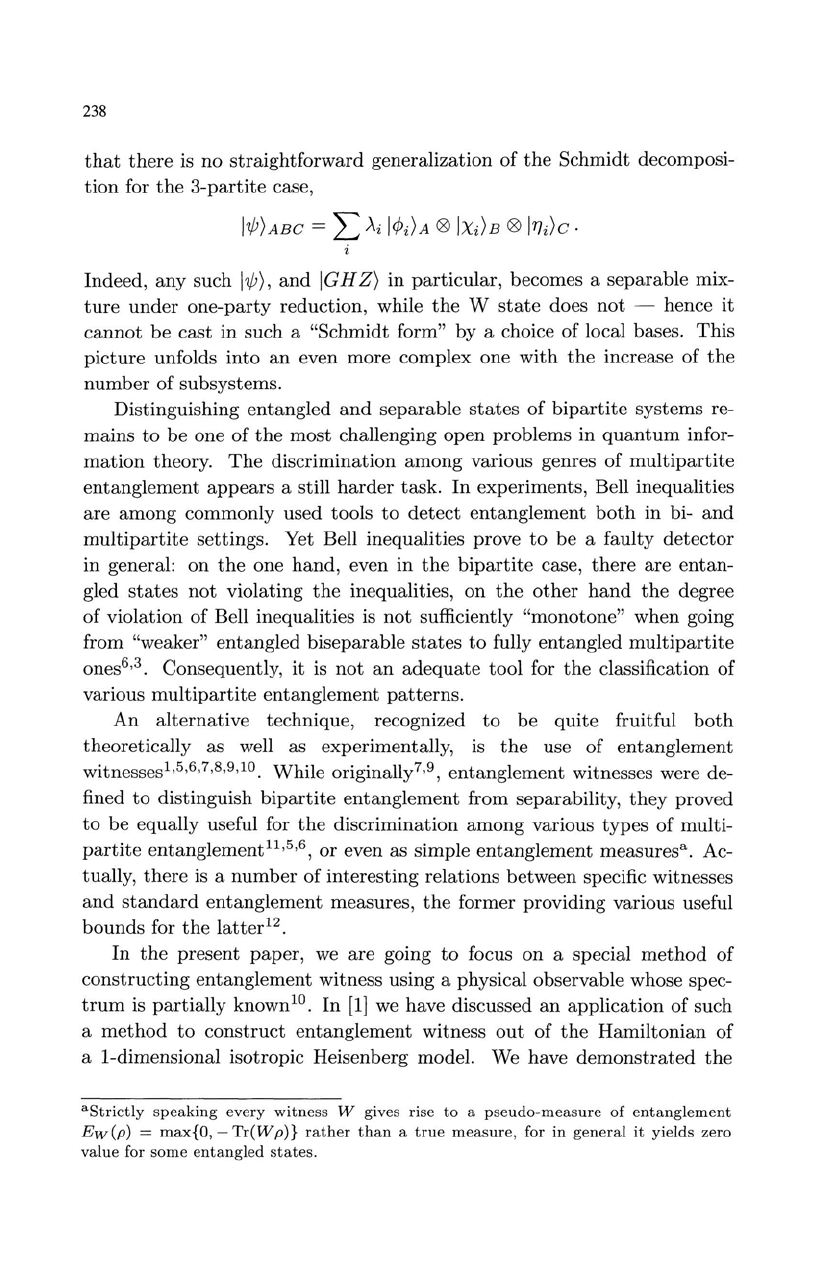
238
that
there
is no
straightforward
generalization
of
the
Schmidt
decomposi-
tion
for
the
3-partite
case,
Indeed,
any
such
I'lj!),
and
IGHZ)
in
particular,
becomes a separable mix-
ture
under
one-party
reduction
, while
the
W
state
does
not
- hence
it
cannot
be
cast
in such a "Schmidt form" by a choice
of
local bases.
This
picture
unfolds into
an
even more complex one
with
the
increase of
the
number
of
subsystems.
Distinguishing
entangled
and
separable
states
of
bipartite
systems re-
mains
to
be
one
of
the
most
challenging
open
problems
in
quantum
infor-
mation
theory.
The
discrimination
among
various genres of
multipartite
entanglement
appears
a still
harder
task.
In
experiments, Bell inequalities
are
among
commonly used tools
to
detect
entanglement
both
in bi-
and
multipartite
settings. Yet Bell inequalities prove
to
be
a faulty
detector
in
general: on
the
one
hand
, even
in
the
bipartite
case,
there
are
entan-
gled
states
not
violating
the
inequalities,
on
the
other
hand
the
degree
of
violation
of
Bell inequalities is
not
sufficiently "monotone" when going
from
"weaker" entangled biseparable
states
to
fully entangled
multipartite
ones
6
,
3.
Consequently,
it
is
not
an
adequate
tool for
the
classification of
various
multipartite
entanglement
patt
erns.
An
alternative
technique, recognized
to
be
quite
fruitful
both
theoretically as well as experimentally, is
the
use
of
entanglement
witnesses
1
,5,6,7,8,9,1O.
While originally7
,9,
entanglement
witnesses were de-
fined
to
distinguish
bipartite
entanglement
from
sep
arability,
they
proved
to
be
equally useful for
the
discrimination
among
various
types
of
multi-
partite
entanglement
ll
,5,6,
or
even as simple
entanglement
measures
a
.
Ac-
tually,
th
ere is a
number
of
interesting
relations between specific witnesses
and
standard
entanglement
measures,
the
former providing various useful
bounds
for
the
latt
er
12.
In
the
present
paper,
we
are
going
to
focus on a special
method
of
constructing
entanglement
witness using a physical observable whose spec-
trum
is
partially
known
10.
In
[1]
we have discussed
an
application of such
a
method
to
construct
entanglement
witness
out
of
the
Hamiltonian
of
a I-dimensional isotropic Heisenberg model. We have
demonstrated
the
aStrictly
speaking
every
witn
ess W gives rise
to
a
pseudo-m
eas
ure
of
entanglement
Ew
(p)
= max{O, -
Tr(W
p)}
rather
than
a
true
measure
, for in
general
it
yields zero
value for
some
e
ntangled
states.
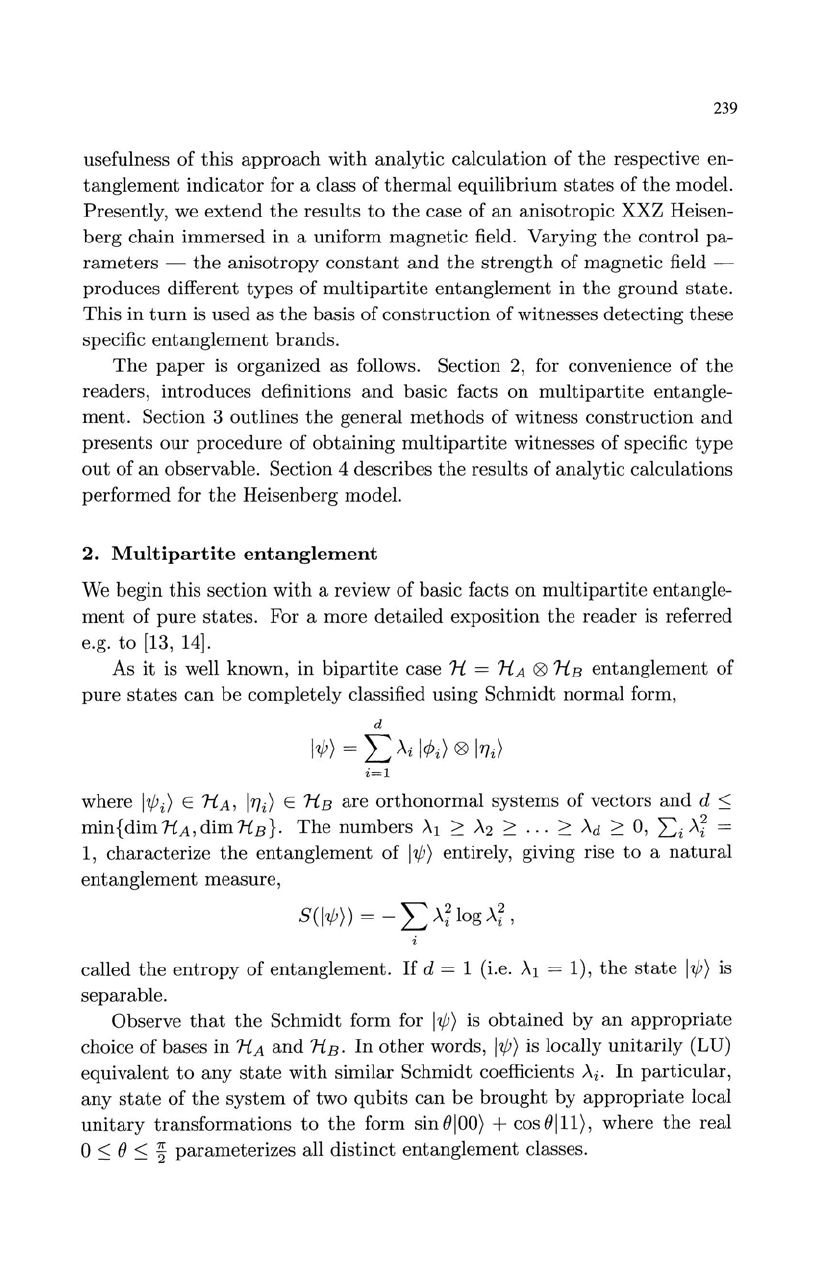
239
usefulness
of
this
approach
with
analytic
calculation of
the
resp
ect
ive en-
tanglement
indicator for a class
of
th
e
rmal
equilibrium
states
of
the
model.
Presently, we
extend
the
res
ults
to
the
case of
an
anisotropic XXZ Heisen-
berg
chain immersed
in
a uniform magnetic field. Varying
the
control pa-
rameters
-
the
anisotropy
constant
and
the
strength
of
magnetic
field -
produces different
types
of
multipartite
e
ntanglement
in
the
ground
state.
This
in
turn
is used as
the
basis of
construction
of
witnesses
detecting
these
specific
entanglement
brands.
The
paper
is organized as follows. Section 2, for convenience
of
the
readers, introduces definitions
and
basic facts
on
multipartite
entangle-
ment.
Section 3 outlines
the
general
methods
of
witness
construction
and
presents
our
procedure
of
obtaining
multipartite
witnesses
of
specific
type
out
of
an
observable. Section 4 describes
the
results
of
analytic
calculations
performed for
the
Heisenberg model.
2.
Multipartite
entanglement
We begin
this
section
with
a review
of
basic facts
on
multipartite
entangle-
ment
of
pur
e
states.
For a more
detail
ed exposition
the
reader
is refe
rred
e.g.
to
[13,
14].
As
it
is well known,
in
bipartite
case H =
HA
@ HB
entanglement
of
pure
states
can
be
compl
ete
ly classified using Schmidt
normal
form,
d
I?p)
= L
Ai
l<P
i) @
l77i)
i=1
where l
?Pi)
E
HA
,
l77i
) E HB
are
orthonormal
systems of vectors a
nd
d
::::;
min{dimH
A,
dimHB}'
The
numbers
Al
~
A2
~
...
~
Ad
~
0,
L i A; =
1,
charact
er
ize
the
entanglement
of
I?p)
entirely, giving rise
to
a
natural
entanglement
measure,
called
the
entr
opy
of
entanglement.
If
d = 1 (i.e. Al = 1),
the
state
I?p)
is
separable.
Observe
that
the
Schmidt
form for I
?p)
is
obtain
ed by
an
appropriate
choice
of
bases
in
HA
and
HB
. In
other
words, I
?p)
is locally
unitarily
(LU)
equivalent
to
any
state
with
similar Schmidt coefficients
Ai.
In
particular,
any
state
of
the
system
of
two
qubits
can
be
brought
by
appropriate
local
unitary
transformations
to
the
form
sinBIOO)
+
cosBlll),
where
the
real
o
::::;
B
::::;
~
parameterizes
all
distinct
entanglement
classes.
